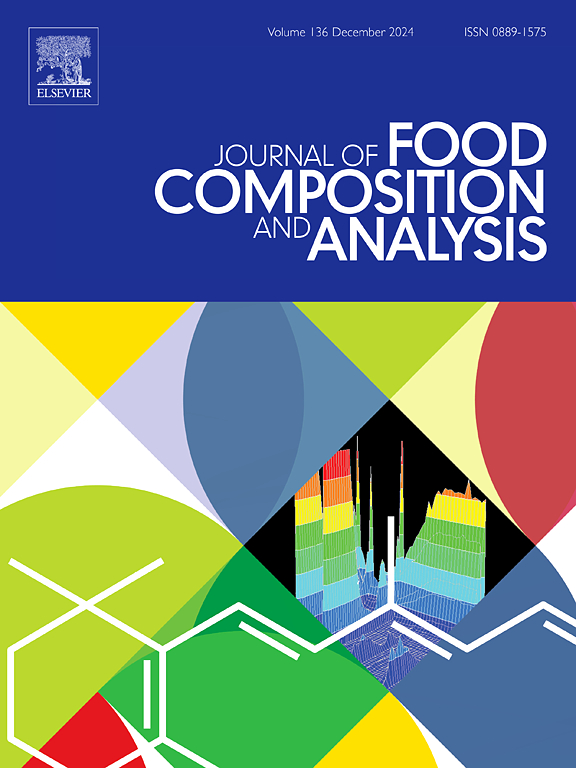Unveiling quality links: External predictors of internal quality in Guanxi honey pomelo (Citrus maxima (Burm.) Merr.) mutants
IF 4.6
2区 农林科学
Q2 CHEMISTRY, APPLIED
引用次数: 0
Abstract
Guanxi honey pomelo is highly valued for its distinctive flavor and nutritional profile. This study evaluated ∼1700 fruits from core orchards in Pinghe, Fujian, China, to investigate the relationships between external appearance and internal quality across two major mutants, Hongrou and Sanhong. Twenty-six key indicators were assessed, encompassing external traits (e.g., fruit shape, peel color, firmness) and internal attributes (e.g., flavor, antioxidants, and minerals). Hongrou and Sanhong pomelos exhibited comparable average fruit weight (∼1300 g), volume (∼2.0 L), density, and shape index, but differed in peel coloration and texture - Hongrou showed higher yellowness (b*), while Sanhong displayed greater redness (a*) and lower firmness. Internally, Sanhong demonstrated enhanced flavor characteristics (TSS: 11.57 %; TSS/TA: 18.2) and higher antioxidant contents (total phenolics: 6.09 g/kg; total flavonoids: 2.56 g/kg; vitamin C: 36.4 mg/100 g), whereas Hongrou had higher mineral concentrations, including Ca, Mg, Zn, and Fe. Canonical correlation analysis (CCA) revealed strong and significant associations between external and internal quality traits (canonical r = 0.70 in Hongrou; 0.66 in Sanhong; P < 0.05). In Hongrou, color b* emerged as the strongest external predictor (loading: 0.777), while in Sanhong, shape index (0.726), peel saturation (0.463), density (-0.648), and weight (-0.525) were key external predictors. These traits were primarily linked to internal indicators such as juice pH, reducing sugars, and TSS/TA ratio. In summary, yellow peel with moderate saturation predicted superior internal quality in Hongrou, while in Sanhong, higher shape index, greater peel saturation, and moderate weight were indicative of enhanced internal quality. Among internal quality dimensions, flavor quality showed the strongest and most consistent correlation with external traits (r = 0.62 in Hongrou; r = 0.59 in Sanhong). Fruit bagging experiments further validated these external-internal correlations. These findings serve as a valuable reference for advancing pomelo quality grading and breeding strategies.
揭示品质环节:广西蜜柚(Citrus maxima, Burm.)内在品质的外部预测因子稳定)突变体
广西蜜柚因其独特的风味和营养价值而受到高度重视。本研究评估了来自中国福建平河核心果园的约1700个果实,以研究两个主要突变体红柔和三红的外观和内在品质之间的关系。评估了26个关键指标,包括外部特征(如水果形状、果皮颜色、硬度)和内部属性(如风味、抗氧化剂和矿物质)。红柔柚和三红柚的平均果重(~ 1300 g)、体积(~ 2.0 L)、密度和形状指数相当,但果皮颜色和质地不同——红柔柚黄度较高(b*),而三红柚红度较高(a*),硬度较低。在内部,三红表现出增强的风味特征(TSS: 11.57 %;TSS/TA: 18.2)和较高的抗氧化剂含量(总酚类物质:6.09 g/kg;总黄酮:2.56 g/kg;维生素C: 36.4 mg/100 g),而红肉的Ca、mg、Zn和Fe等矿物质含量较高。典型相关分析(Canonical correlation analysis, CCA)显示,红肉品种的外部品质性状与内部品质性状之间存在显著的相关性(Canonical r = 0.70;三红0.66;P & lt; 0.05)。在红肉中,颜色b*是最强的外部预测因子(负载:0.777),而在三红中,形状指数(0.726)、果皮饱和度(0.463)、密度(-0.648)和重量(-0.525)是关键的外部预测因子。这些性状主要与果汁pH、还原糖和TSS/TA比值等内部指标有关。综上所述,黄果皮饱和度适中预示着红肉的内在品质较好,而三红的果皮形状指数高、果皮饱和度高、果皮重量适中预示着内在品质较好。内部品质维度中,风味品质与外部品质的相关性最强且最一致(r = 0.62);r = 0.59(三红)。水果套袋实验进一步验证了这种内外相关性。研究结果可为制定柚品质分级和选育策略提供参考。
本文章由计算机程序翻译,如有差异,请以英文原文为准。
求助全文
约1分钟内获得全文
求助全文
来源期刊

Journal of Food Composition and Analysis
工程技术-食品科技
CiteScore
6.20
自引率
11.60%
发文量
601
审稿时长
53 days
期刊介绍:
The Journal of Food Composition and Analysis publishes manuscripts on scientific aspects of data on the chemical composition of human foods, with particular emphasis on actual data on composition of foods; analytical methods; studies on the manipulation, storage, distribution and use of food composition data; and studies on the statistics, use and distribution of such data and data systems. The Journal''s basis is nutrient composition, with increasing emphasis on bioactive non-nutrient and anti-nutrient components. Papers must provide sufficient description of the food samples, analytical methods, quality control procedures and statistical treatments of the data to permit the end users of the food composition data to evaluate the appropriateness of such data in their projects.
The Journal does not publish papers on: microbiological compounds; sensory quality; aromatics/volatiles in food and wine; essential oils; organoleptic characteristics of food; physical properties; or clinical papers and pharmacology-related papers.
 求助内容:
求助内容: 应助结果提醒方式:
应助结果提醒方式:


